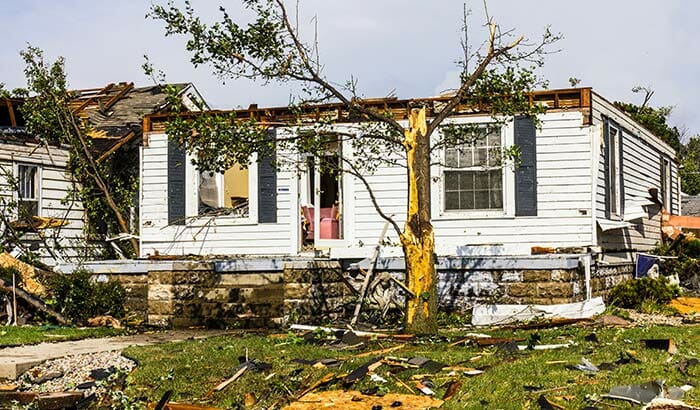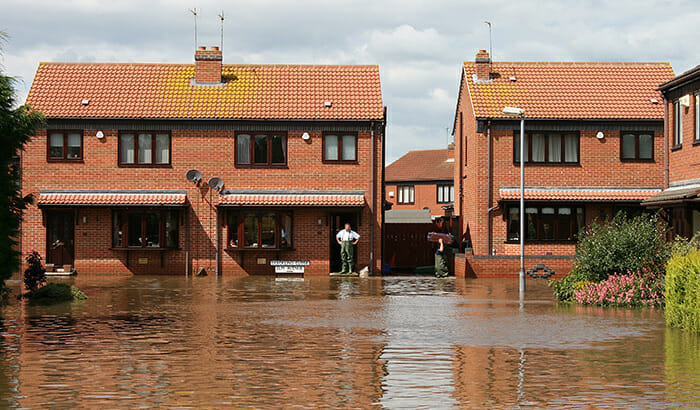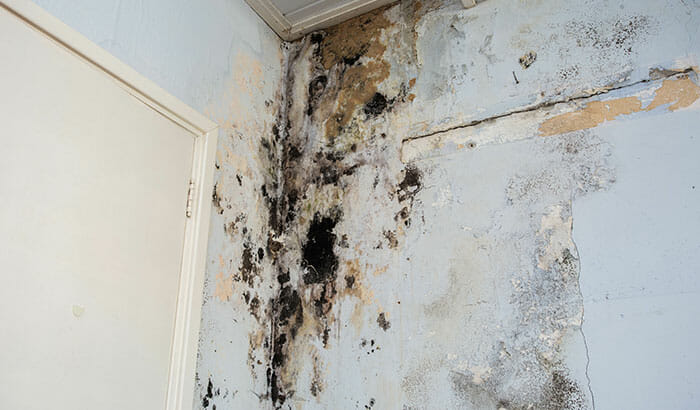High winds can cause a great deal of damage to your home, but what does wind damage look like? What kinds of damage will an insurance company cover after a storm?
Wind damage can come in many different forms. It can cause direct damage to homes by blowing off shingles and even destabilizing the structure itself. Wind can also cause damage to a home by hurling other objects into it, such as downing trees and powerlines or accelerating smaller objects into it. Wind can break windows, collapse roofs, and even topple a house entirely.
Let’s look more closely at how wind damages homes, how you can protect your home from wind damage, and what homeowners insurance will and will not cover.
What Damage Can Wind Do to a Home?
The kind of damage a wind storm can do to a house depends largely on how fast the wind is blowing.
At 50 mph, winds can do superficial damage to older structures. Shingles and other loose elements may start to blow off.
At 75 mph, wind damage will occur to more solid structures. Weaker tree limbs may start to fall.
At 100 mph, the wind will down trees. Mobile homes may sustain extensive damage. A mailbox may become a projectile and be thrown against your home. Your shingles and rain gutters are not safe.
At more than 100 mph, heavy damage can occur to even very sturdy houses. Roofs will likely be damaged, windows broken, and walls buckled. Even the strongest trees will be blown down and potentially onto your house.
When Does Wind Damage Happen?
Most wind storms don’t produce high enough wind speed to damage structures. But occasionally, they do. Here are a few examples of storm scenarios that can produce winds that will damage homes:
Microbursts: A microburst is a downdraft of air that occurs in a small area during a thunderstorm. It can reach wind speeds of over 100 mph, which is fast enough to break tree limbs and cause damage to shingles, rain gutters, and siding. But because microbursts don’t create sustained high-speed winds, they won’t do the same damage as other storms.
Hurricanes: Hurricanes form over warm ocean waters where they can build up speeds from 75 to 150 mph and higher. Even the smallest tropical storms can snap tree branches and cause damage to shingles and siding. The strongest hurricanes can topple the most well-built homes, even if flooding doesn’t get to them.
Tornadoes: While tornadoes don’t create the same breadth of destruction as hurricanes, their winds can be much stronger. Though rare, the strongest tornadoes can reach wind speeds in excess of 300 miles per hour. A storm like this could completely dismantle a house within seconds. And some tornadoes have a long path of destruction. Luckily for most of us, we don’t live in areas where tornadoes are prevalent.
How Can You Protect Your Home?
It may not sound like there’s a lot you can do to protect your home from this kind of damage, but there are some important things you can do.
- Keep your home well maintained. Make sure your shingles are tight, your siding is solid, and your downspouts are secure. This will help prevent the most common wind damage you’re likely to see.
- Keep your yard free of clutter. Often the damage that occurs from wind is not caused by the wind directly, but by other items it can pick up and throw at your home. Removing the closest possible projectiles from your home will go a long way to avoiding this kind of damage.
- Maintain the trees near your home. This includes pruning trees to promote strength. A tree with one main trunk is stronger than one with a split one. Remove dead limbs. Also, removing damaged or unbalanced trees will help keep your home safe.
- If you know you may be in the path of a tornado or hurricane, board up your windows with plywood.
- Make sure your homeowner’s insurance policy will cover wind damage.
What Damage Will Homeowner’s Insurance Cover After a Wind Storm?
Typically, homeowner’s insurance covers wind damage to your home, including tornadoes and hurricanes. It will normally cover the following kinds of damage:
- Damage to siding and shingles caused by wind
- Structural damage caused by wind, including collapsed roofs and walls
- Fallen tree damage if the tree fell because of wind
- Damage caused by snow and rainwater that entered through a wind-damaged roof
Some lower-end policies don’t cover or include reduced coverage for wind damage, so it’s important to know the terms and conditions of your policy before anything happens. You might need to buy a specific policy for wind damage.
You may find that you have the burden to prove the damage was caused by wind and not some other mitigating circumstance. For example, if a tree limb falls on your home during a storm, but it had some infection prior to the break, that may disqualify it.
It’s also important to know exactly what kind of compensation to expect before a disaster happens. Know how much of a deductible you have, whether your policy covers you for actual cash value or replacement value, and if it covers detached structures such as sheds and fences.
When the Damage is Done, Bull Matrix Restoration Can Help
When dealing with insurance following a disaster, it’s easy to become cynical about trusting those you pay to protect you. We’d like to help restore some of your confidence in mankind when you need it most. At Bull Matrix, we do this work because we actually like helping people.
When wind damage occurs, we can provide generator power, clean up debris, repair minor roof damage, and temporarily patch holes in your roof to prevent additional damage. We also have the skills to deal with water and fire damage if you need it. Reach out to us as soon as you realize you need help. We’re a short drive to most places in Utah County and Salt Lake County.



